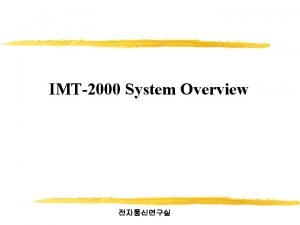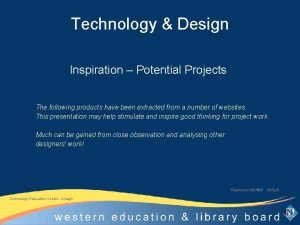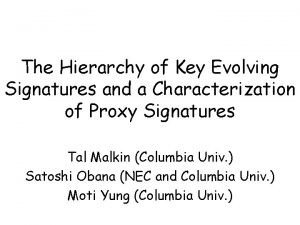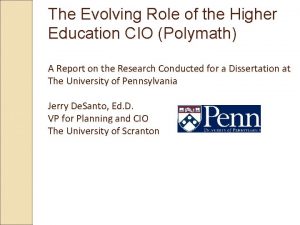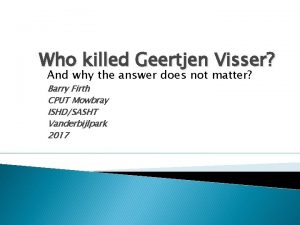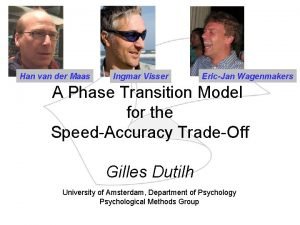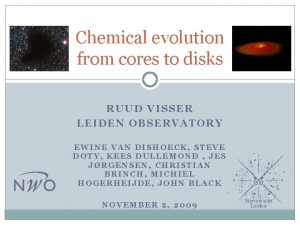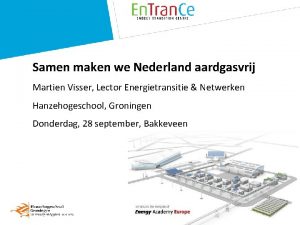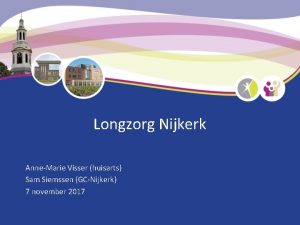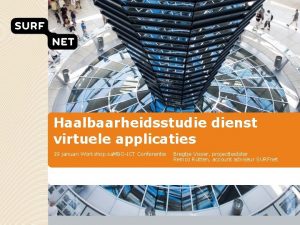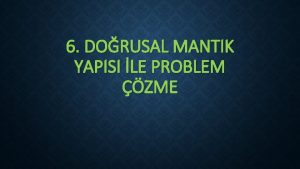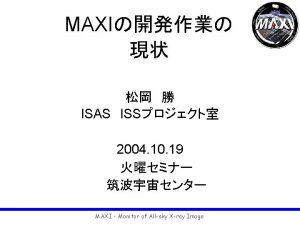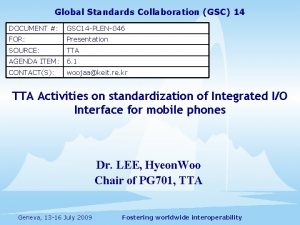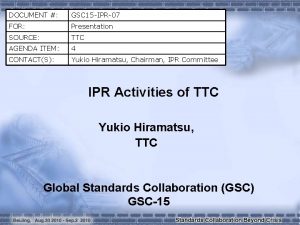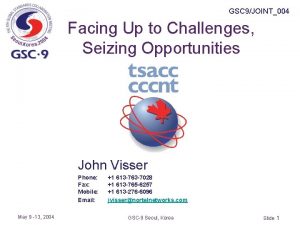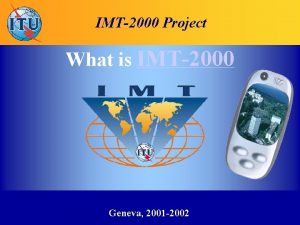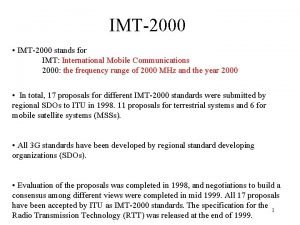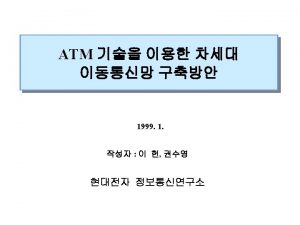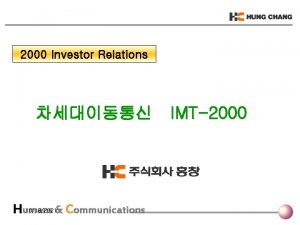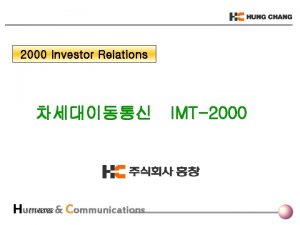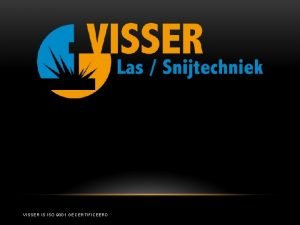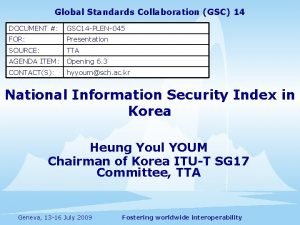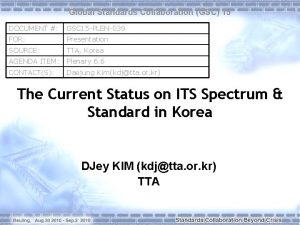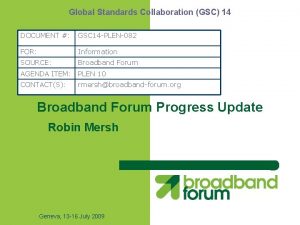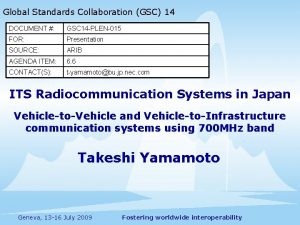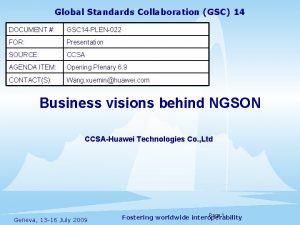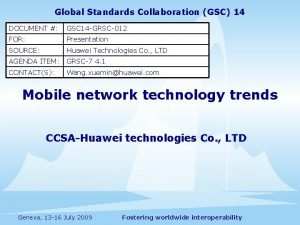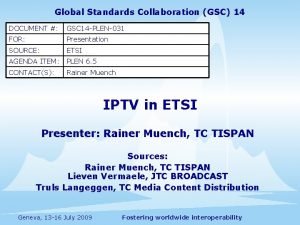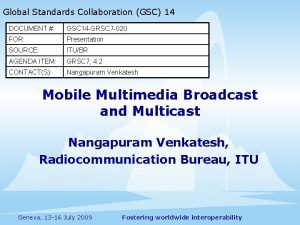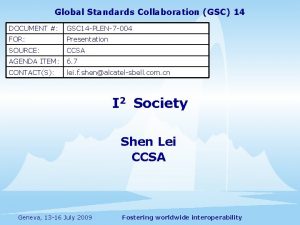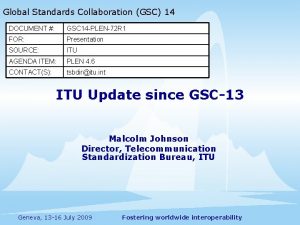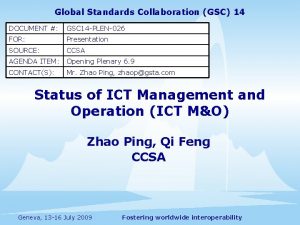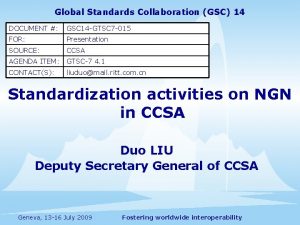GSC 9JOINT004 Evolving IMT2000 Standards John Visser Phone






















- Slides: 22

GSC 9/JOINT_004 Evolving IMT-2000 Standards John Visser Phone: Fax: Mobile: Email: May 9 -13, 2004 +1 613 -763 -7028 +1 613 -765 -6257 +1 613 -276 -6096 jvisser@nortelnetworks. com GSC-9 Seoul, Korea Slide 1

IMT-2000 Revolution is Underway • Mobile overtakes fixed on a global basis Source: http: //www. itu. int/osg/spunews/2003/flash/september. html May 9 -13, 2004 GSC-9 Seoul, Korea Slide 2

IMT-2000 Revolution is Underway • Strong advantages over first building ubiquitous fixed infrastructure in developing markets Source: http: //www. itu. int/osg/spunews/2003/flash/september. html Slide 3

What comes next? • Alternatives: – Could just focus only on mobile networks and how they evolve (needs to be done anyway) – Could look just at the integration of fixed and mobile networks (will happen anyway) • Should look at the general case: convergence of traditional fixed networks, mobile networks, information technology and broadcast May 9 -13, 2004 GSC-9 Seoul, Korea Slide 4

End Objective • Provide the best possible suite of services and capabilities to end users in a seamless and effortless manner – as straightforward as plugging an appliance into an electrical outlet? • The right standards framework and the right standards within that framework will be essential Graphics from: http: //www. goinginstyle. com/gis/body_category. asp? dept_id=2 May 9 -13, 2004 GSC-9 Seoul, Korea Slide 5

4 G? • Many talk very easily about “ 4 G” – everyone’s Marketing Dept. touts “ 4 G” products • Reality: – a continuum of capabilities which extend and enhance 3 G, expected to include: • higher data rates (including WLAN integration) • improved roaming • true inter-system mobility management May 9 -13, 2004 GSC-9 Seoul, Korea Slide 6

Wireless Landscape Wireless Wide Area Network (WWAN) • • • Metro/Geographical area “Always On” Services Ubiquitous public connectivity with private virtual networks Mobility Fixed/ Desktop DECT Bluetooth Outside Campus 0. 1 May 9 -13, 2004 1 Hiper. LAN 2 802. 11 a, g Walk Public or Private Site or Campus Enterprise / premises application voice & data network extension Nomadic / “pull” services Non-licensed spectrum • • >3 G 802. 11 b Within Campus Fixed CDMA 2000 1 X EV-DO & UMTS Walk • • CDMA 2000 1 X GSM/GPRS Vehicle Wireless Local Area Network (WLAN) 10 GSC-9 Seoul, Korea LAN 100 Mbps Slide 7

User’s Perspective • 1 user: 1 terminal Increasing Mobility Expectation Mobile • 1 user: n terminals Re ali ty Mobile PDA Increasing service content: voice to multimedia May 9 -13, 2004 Laptop • n users: 1 terminal GSC-9 Seoul, Korea Slide 8

Operator’s Landscape • “Fast” mobility: mobile terminal with seamless voice, low speed data hand-off • “Nomadic” mobility: session in one hot spot; move between adjacent hot spots • Ad hoc networks: use spare resources of neighbours for dynamic connectivity • Terminal mobility: plug into any access • User mobility: use any terminal May 9 -13, 2004 GSC-9 Seoul, Korea Slide 9

Beyond IMT-2000 • Heterogeneity of installed base means capabilities will not be uniformly available • “ 4 G” will not be uniformly deployed, so: – need to characterize the local capabilities – terminals need to adapt to local environment • Much is possible but ideals that could be achieved must be tempered by the reality of what can be paid for May 9 -13, 2004 GSC-9 Seoul, Korea Slide 10

W+/W- Integration • How should this be approached? – from a fixed network perspective: add functions to also support mobile users? – from a wireless network perspective: what is needed to also support fixed users? • Points of view – fixed network specialists tend to start from first – wireless network specialists tend to start from second May 9 -13, 2004 GSC-9 Seoul, Korea Slide 11

W+/W- Integration: perspective change? • Are we just (re-)using some wireless network solutions to provide similar services in a similar way to fixed users? • Or, are we missing a key element? – wireless networks have long been treated as a means of access to fixed network services – now starting to see fixed networks being used as a means of access to wireless networks • Are the roles reversing? or just equalizing? May 9 -13, 2004 GSC-9 Seoul, Korea Slide 12

W+/W- Convergence Underway • ITU-T: – Rec. Q. 1761 “Principles and Requirements for Convergence of Fixed and Existing IMT-2000 Systems” – Q. F/13 “NGN mobility and fixed-mobile convergence” – Q. K/16 “Mobility for Multimedia Systems and Services” – Multiple Qs in SSG • ETSI TISPAN: applying 3 GPP Rel. 6 IMS • Others certainly working subject May 9 -13, 2004 GSC-9 Seoul, Korea Slide 13

WWAN and WLAN Integration • Concept: based on what user is doing and on availability of local resources, switch seamlessly between WLAN and WWAN to optimize both user experience and resource utilization – users demanding high data rates more likely to be nomadic: use WLAN where available – voice users could be served by either: could use WLAN to conserve WWAN resources May 9 -13, 2004 GSC-9 Seoul, Korea Slide 14

WLAN and Fixed Integration • Mesh networks – utilize concept to optimize backhaul • Ad hoc networks – minimize infrastructure requirements for low user density or in an emergency where infrastructure damaged or destroyed May 9 -13, 2004 GSC-9 Seoul, Korea Slide 15

Convergence This animated chart is provided as three discrete charts at the end of this package. Infrastructure Application Servers Intelligent Infrastructure Call Server MGCF Services CSCF/SCM Packet Based HLR/ HSS GGSN Call Server MGW HLR/ HSS Call Server MGCF MGW R 4 PDF PSTN BICN PDG PDSN GSM May 9 -13, 2004 Internet Intranet Call Server PDG Internet Intranet Call Server MGCF PDG MGW PDSN PSTN SGSN R 4 BICN HA HA PSTN Architectural PDSN Internet Intranet SGSN GGSN PDF UMTS CDMA WLAN DSL/Cable Access Independence UMTS CDMA WLAN DSL/Cable GSC-9 Seoul, Korea Slide 16

NGN • General case: convergence of fixed and mobile networks, data and broadcast – “Global Information Infrastructure” • GII now referred to as “Next Generation Network” – Do standards for IMT-2000 and “systems beyond” become NGN standards? May 9 -13, 2004 GSC-9 Seoul, Korea Slide 17

GII is all about convergence Internet, Broadcasting, Telephony, . . . TODAY Consumer Entertainment Telecommunications The NGN 2004 Project will establish implementation guidelines and standards for the realization of Next Generation Networks based on GII concepts. NEAR FUTURE GII Consumer Entertainment Computer information Telecommunications AIM Consumer Entertainment GII Telecommunications Computer information May 9 -13, 2004 GII Computer information • Y-series Recommendations: GII • Per Fig. 5 -1/Y. 110 – GII is at the centre of the threefold industry convergence GSC-9 Seoul, Korea Slide 18

Conclusion • IMT-2000 and systems beyond: – must ensure we address convergence starting from the right perspective – mobility is an integral part of and the starting point for NGN – studies require identification and review of pre -conceptions and assumptions to test their validity May 9 -13, 2004 GSC-9 Seoul, Korea Slide 19

Convergence - Nonanimated - Step 1 Call Server PDF HLR/ HSS Call Server MGCF MGW Call Server Internet Intranet Call Server MGCF GGSN PDG PDSN PSTN R 4 BICN GSM May 9 -13, 2004 PDG MGW HA SGSN Architectural Internet Intranet UMTS CDMA WLAN DSL/Cable GSC-9 Seoul, Korea Slide 20

Convergence - Nonanimated - Step 2 Application Servers Call Server Services PDF HLR/ HSS Call Server MGCF MGW Call Server Internet Intranet Call Server MGCF GGSN PDG PDSN PSTN R 4 BICN GSM May 9 -13, 2004 PDG MGW HA SGSN Architectural Internet Intranet UMTS CDMA WLAN DSL/Cable GSC-9 Seoul, Korea Slide 21

Convergence - Nonanimated - Step 3 Application Servers Infrastructure Intelligent Infrastructure Call Server MGCF Services CSCF/SCM Packet Based HLR/ HSS MGW GGSN PSTN HA Internet Intranet PDG SGSN R 4 BICN Architectural PDSN PDF GSM UMTS CDMA WLAN DSL/Cable Access Independence May 9 -13, 2004 GSC-9 Seoul, Korea Slide 22
 Cdma 2000 architecture
Cdma 2000 architecture Evolving design
Evolving design A framework for clustering evolving data streams
A framework for clustering evolving data streams Key evolving signature
Key evolving signature Evolving
Evolving Coenraad visser
Coenraad visser Karl visser
Karl visser Han van der maas
Han van der maas Ruud visser
Ruud visser Rien visser
Rien visser Martien visser energie
Martien visser energie Annemarie visser
Annemarie visser Syntra haalbaarheidsstudie
Syntra haalbaarheidsstudie Gsc chromatography
Gsc chromatography Gsç
Gsç Gsç çizelgesi
Gsç çizelgesi Gsc 인터내셔널
Gsc 인터내셔널 Doğrusal mantık yapısı
Doğrusal mantık yapısı Gsc 青学
Gsc 青学 Global standards collaboration
Global standards collaboration Ttc organization chart
Ttc organization chart Frost beamformer
Frost beamformer Factors necessary for appropriate service standards
Factors necessary for appropriate service standards
